Strontium Hawk (240GB) Review
by Kristian Vättö on June 25, 2013 8:00 AM ESTAnandTech Storage Bench 2011
Two years ago we introduced our AnandTech Storage Bench, a suite of benchmarks that took traces of real OS/application usage and played them back in a repeatable manner. Anand assembled the traces out of frustration with the majority of what we have today in terms of SSD benchmarks.
Although the AnandTech Storage Bench tests did a good job of characterizing SSD performance, they weren't stressful enough. All of the tests performed less than 10GB of reads/writes and typically involved only 4GB of writes specifically. That's not even enough exceed the spare area on most SSDs. Most canned SSD benchmarks don't even come close to writing a single gigabyte of data, but that doesn't mean that simply writing 4GB is acceptable.
Originally we kept the benchmarks short enough that they wouldn't be a burden to run (~30 minutes) but long enough that they were representative of what a power user might do with their system. Later, however, we created what we refer to as the Mother of All SSD Benchmarks (MOASB). Rather than only writing 4GB of data to the drive, this benchmark writes 106.32GB. This represents the load you'd put on a drive after nearly two weeks of constant usage. And it takes a long time to run.
1) The MOASB, officially called AnandTech Storage Bench 2011—Heavy Workload, mainly focuses on the times when your I/O activity is the highest. There is a lot of downloading and application installing that happens during the course of this test. Our thinking was that it's during application installs, file copies, downloading, and multitasking with all of this that you can really notice performance differences between drives.
2) We tried to cover as many bases as possible with the software incorporated into this test. There's a lot of photo editing in Photoshop, HTML editing in Dreamweaver, web browsing, game playing/level loading (Starcraft II and WoW are both a part of the test), as well as general use stuff (application installing, virus scanning). We included a large amount of email downloading, document creation, and editing as well. To top it all off we even use Visual Studio 2008 to build Chromium during the test.
The test has 2,168,893 read operations and 1,783,447 write operations. The IO breakdown is as follows:
| AnandTech Storage Bench 2011 - Heavy Workload IO Breakdown | ||||
| IO Size | % of Total | |||
| 4KB | 28% | |||
| 16KB | 10% | |||
| 32KB | 10% | |||
| 64KB | 4% | |||
Only 42% of all operations are sequential; the rest ranges from pseudo to fully random (with most falling in the pseudo-random category). Average queue depth is 4.625 IOs, with 59% of operations taking place in an IO queue of 1.
Many of you have asked for a better way to really characterize performance. Simply looking at IOPS doesn't really say much. As a result we're going to be presenting Storage Bench 2011 data in a slightly different way. We'll have performance represented as Average MB/s, with higher numbers being better. At the same time we'll be reporting how long the SSD was busy while running this test. These disk busy graphs will show you exactly how much time was shaved off by using a faster drive vs. a slower one during the course of this test. Finally, we will also break out performance into reads, writes, and combined. The reason we do this is to help balance out the fact that this test is unusually write intensive, which can often hide the benefits of a drive with good read performance.
There's also a new light workload for 2011. This is a far more reasonable, typical every day use case benchmark. It has lots of web browsing, photo editing (but with a greater focus on photo consumption), video playback, as well as some application installs and gaming. This test isn't nearly as write intensive as the MOASB but it's still multiple times more write intensive than what we were running last year.
We don't believe that these two benchmarks alone are enough to characterize the performance of a drive, but hopefully along with the rest of our tests they will help provide a better idea. The testbed for Storage Bench 2011 has changed as well. We're now using a Sandy Bridge platform with full 6Gbps support for these tests.
AnandTech Storage Bench 2011—Heavy Workload
We'll start out by looking at average data rate throughout our heavy workload test:
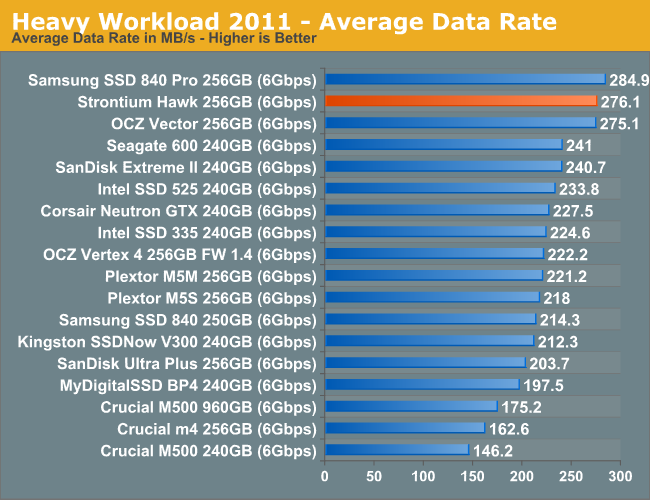
The high sequential throughput and peak performance is highlighted in our Heavy suite.
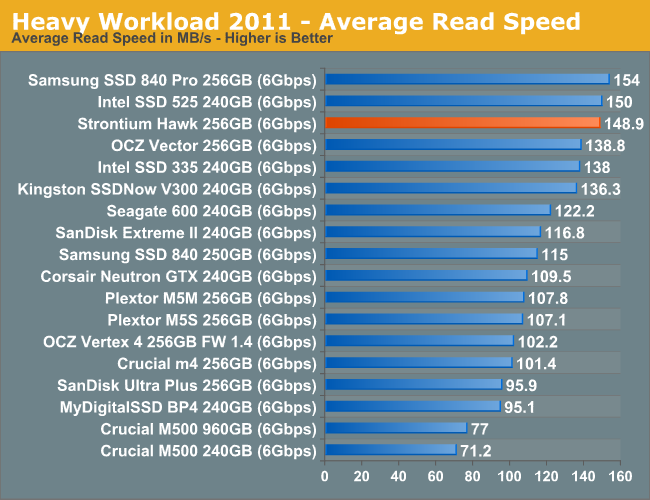
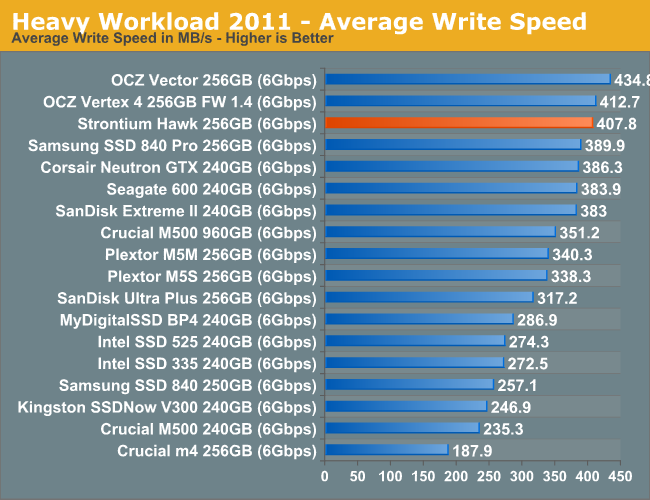

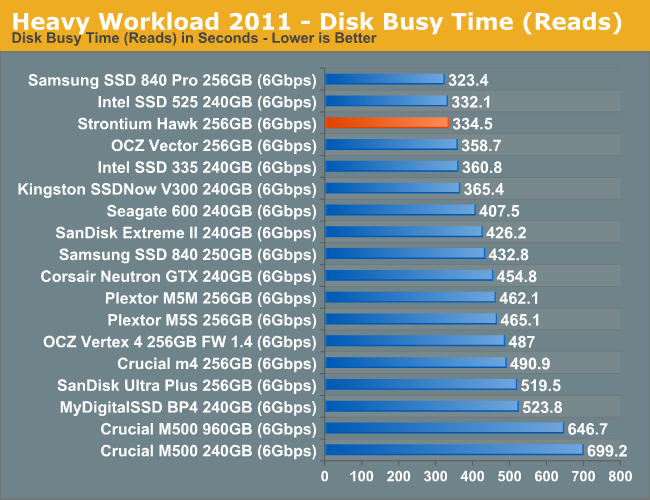
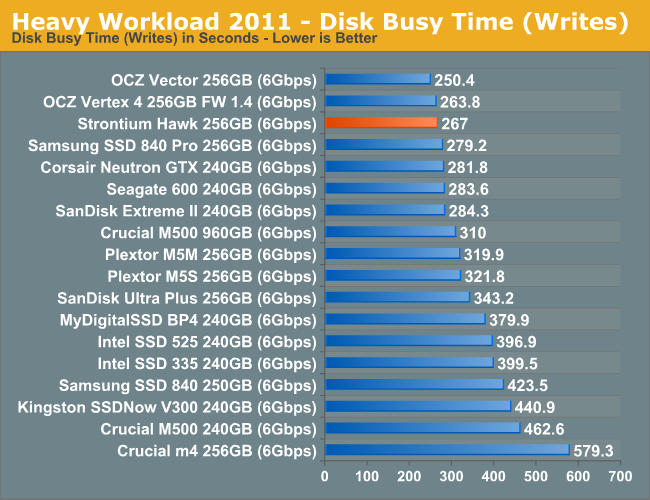










26 Comments
View All Comments
karasaj - Tuesday, June 25, 2013 - link
Every time I kept reading that, I kept thinking about how no name suppliers would be bad... hard to remember it's from Toshiba, haha. Good luck to them. Nice review :) Power consumption seems obnoxiously low at load.mcveigh - Tuesday, June 25, 2013 - link
Strontium Hawk is the name of my spirit animal!jmke - Tuesday, June 25, 2013 - link
not the best product name I must admit... might not do well in Benelux ;)http://translate.google.com/?hl=en#nl/en/stront
Pessimism - Tuesday, June 25, 2013 - link
Why poo-poo the manufacturer for taking a stand to end the 1000^3 garbage? Everyone should follow suit and label with formatted capacity.hedleyroos - Tuesday, June 25, 2013 - link
Your use of the word "poo-poo" is ironically funny to people who speak Afrikaans (and probably Dutch and Flemish) since "stront" means "poo". They have zero chance of succeeding in those markets.Kristian Vättö - Tuesday, June 25, 2013 - link
Like I said, it's pretty much useless for a small OEM like Strontium to try and change the industry.piroroadkill - Tuesday, June 25, 2013 - link
It should then say 240GiB...dealcorn - Tuesday, June 25, 2013 - link
OK. Laptops outsell desktops and you were unable to test with HIPM and DIPM enabled and no mention was made of DEVSLP support which is a big deal for any Haswell mobile device. By impairing the relevance of the review to typical use cases, someone properly earns a demerit.You need a Haswell mobile device to test with if you want to maintain relevance to the mainstream market. I would complain to my bosses that you need better hardware support to perform at the level they and readers expect of you.
Kristian Vättö - Tuesday, June 25, 2013 - link
I'll be brutally honest here. Just because we are AnandTech doesn't mean that we have piles of laptops laying around, especially ones that are based on a chip that was released less than a month ago. All reviewers want Haswell-based devices at the moment, the supply is extremely tight. Usually laptops only have a review time of two weeks or so because the same system may be sent to others once it's been returned. Obviously reviewers who are actually going to review the system are the first priority, so it'd be really hard for me to get one because 1) I would only be using it for one test 2) I couldn't send it back anytime soon. In other words, the manufacturer wouldn't get much bang for their marketing $ because they wouldn't get much visibility, which is the reason review samples exist in the first place.I know there's the option of buying one but again, I'll be honest here: It would be around $1000 for just one test. I would definitely take one if Anand paid for it but as far as I've understood, Anand isn't into spending thousands on test equipment (keep in mind that the financial situation isn't all that good for us since it's usually the marketing budgets that get cut when bad times hit, so it's harder for us to get advertisers). There's a ton of stuff I'd love to have as they would really take our SSD tests (especially power related) to a next level but I'm not the one making decisions.
We have talked with Intel and ASUS and asked if there's anyway HIPM/DIPM could be enabled on a desktop system (even via custom firmware) but as far as I know, they are not up for that.
Trust me, I would take a Haswell laptop on a heartbeat if someone gave me one, but I hope you also understand that we don't get whatever we want from manufacturers.
dealcorn - Tuesday, June 25, 2013 - link
Well handled and responsive to my concern. So, BK is telling his team we have a winning hand but we need to release products faster. Anandtech is arguably the premier web site consumers turn to for help understanding how new technology benefits them. Intel, however, makes no effort to ensure you have access to the hardware necessary to explain why consumers should value the new stuff. If Intel is trying to increase the cadence, they should step up their game. If Intel does not understand that, it lessens BK's credibility.